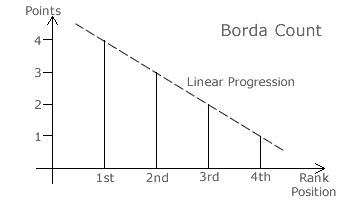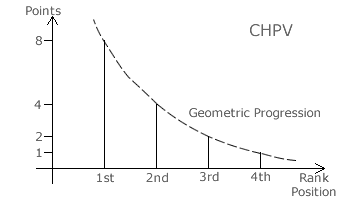Description: Introduction to GV and CHPV
When a group of people have to make a collective choice between three or more candidates or proposals, there are countless different voting systems from which to choose. See the voting system section of Wikipedia for examples and an overview. Many systems allow voters to express their preferences for candidates or options in rank order. These ranked 'preferential voting' methods can be further subdivided into different classes. One such class is 'positional voting' where each consecutive position within the ordered rank is given a weighted value or number of points. The candidate or option gaining the most points overall wins. Even this class can be further subdivided according to how the points or weights are allocated to the rank positions.
The most well-known positional voting system is the Borda Count. It is named after the French psephologist Jean-Charles de Borda. Following the French Revolution, decisions were taken collectively by many people (democracy) rather than by just one (monarchy). The Borda Count awards one point less to each candidate as their rank position declines. For example, with four candidates standing for election, the most preferred or first preference candidate gets four points, the second preference one gets three points, the third preference two points and the remaining one just one point.


The actual rank position weightings do not matter provided that the difference in points between consecutive positions is fixed. This difference is hence called the common difference. An identical ranking of the four candidates is also achieved when using a common difference of one quarter and consecutive weights of three quarters, one half, one quarter and zero. Such a sequence of values is called a 'linear progression' as a plot of the number of points against rank position produces a straight line graph; see example opposite.
Another obvious mathematical way to allocate points is to use a 'geometric progression' instead. Hence the name Geometric Voting (GV) for this particular class of positional voting. Here, it is not a fixed difference in points between consecutive rank positions that matters but a fixed factor. This factor is called the common ratio and its value can be anything between zero and one for GV. Unlike the arbitrary value of a common difference, the chosen value for a common ratio has a critical effect on the ranking of the candidates.
Suppose the mid-value of one half is used as the common ratio and four candidates are again standing for election. Using GV, the first preference candidate may get eight points, the second preference one four points, the third preference two points and the remaining one again only one point; see graph opposite. Alternatively, employing weights of one, one half, one quarter and one eighth achieves the same election outcome as the common ratio is unchanged. Notice that each candidate gets half the points awarded to the adjacent higher-ranked one. Using GV with a common ratio of one half is called Consecutively Halved Positional Voting (CHPV).
Positional voting is a means of translating the numerous individual rank order preferences of the voters into one collective and decisive rank-ordering of the candidates. These preferences are expressed by voters on a 'ranked ballot'. Usually, but not always, a single winner is elected from such ranked ballot elections. As will be demonstrated later, ranked ballot CHPV is a very special case of GV as it has a number of crucial properties in relation to the Borda Count and other single-winner voting systems. This is especially true with regard to the thwarting of any attempted manipulation of an election outcome by candidates or parties.
For elections that generate multiple winners, a 'party-list' voting system may be employed to ensure proportionality between the parties. Here, each party issues a rank-ordered list of its own candidates and, if the party receives sufficient support, some of its top-ranked candidates will be elected. Positional voting weights can also be used to reflect the relative weight of the rank position of each candidate on a particular list. Using party-list CHPV for example, the second- and third-placed candidates will have a half and a quarter of the score of the top-ranked one respectively. Within specified limits, it will be shown that CHPV can achieve remarkably proportional outcomes in certain multiple-winner elections.
GV covers a class or range of voting systems where defining the specific common ratio determines the particular system adopted. As it can simultaneously handle any common ratio with an unlimited number of voters and an unlimited number of candidates, GV is promoted here as a very useful tool for the primary purpose of analysis, evaluation and comparison. However, with their very considerable merits, this website is dedicated to promoting ranked ballot CHPV and party-list CHPV as more suitable alternatives (given specified conditions) to other single- or multiple-winner voting systems respectively.
Proceed to next section > Description: Analogy
Return to previous page > Home
